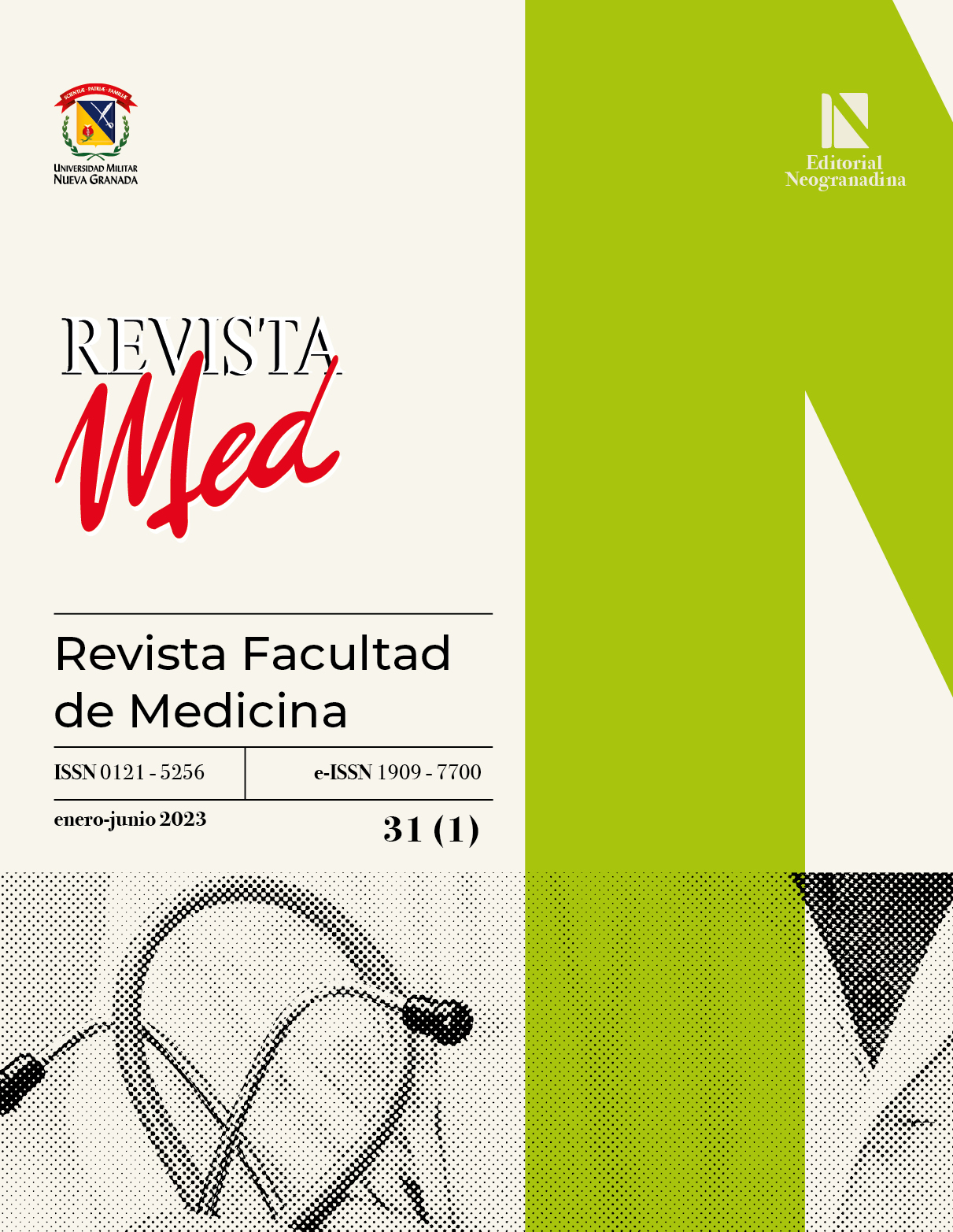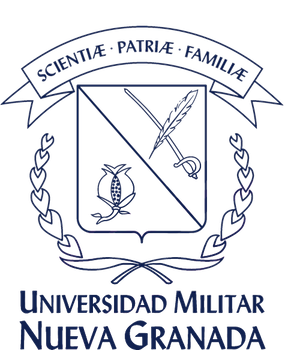IMPACT OF GENOMIC CHARACTERIZATION IN PATIENTS WITH SPINAL MUSCULAR ATROPHY NO 5q
Abstract
Introduction: Spinal Muscular Atrophy (SMA), is defined as a set of hereditary neurodegenerative disorders causing phenotypic and genotypic variability generating an impact on quality of life, psychosocial, emotional and functional development, considered in Colombia orphan disease in relation to its low prevalence, chronicity and high complexity. Objective: To describe, characterize and correlate phenotypically and genotypically a patient with clinical suspicion of neurodegenerative disease. Clinical case: A 32-year-old female patient with clinical picture consisting of equinismus, varus, hindfoot supination, right forefoot adduction and wrist limitation with subsequent weakness and muscle atrophy predominantly in the lower limbs, generalized areflexia and positive Gowers sign, with suspicion of progressive degenerative neuromuscular disease, endocrine, neuromuscular, cardiovascular studies, sural nerve biopsy and genetic study were requested. Results: Biopsy of sural nerve with loss of axons with little demyelination, and genomic study clinical exome sequencing trio performed using Illumina technology with identification of variants with pathogenic clinical significance in the NOD2 gene with heterozygous zygosity and homozygous DYNC2H1, finally gene interaction network is performed by GeneMania program determining gene associations. Conclusion: The diagnosis of SMA represents a challenge due to its wide phenotypic-genotypic variability, although most patients are due to variants in the SMN1 gene there are other non-5q genes associated to this pathology, a specific diagnosis impacts on the treatment, prognosis and morbimortality attributed, establishing heritability risk and genetic counseling for the sake of preventive, predictive, personalized and participatory medicine.
Downloads
References
Erazo Torricelli R. Neuromuscular U. Actualización en tratamientos de la atrofia muscular espinal. Medicina (Buenos Aires) 2022;82(Supl. III):76-81. Disponible en: https://www.medicinabuenosaires.com/revistasvol82-22/s3/76s3.pdf
Bodamer OA. Spinal Muscular Atrophy. UpToDate.Disponible en: https://www.uptodate.com/contents/spinal-muscular-atrophy?search=atrofia%20muscular%20espinal&source=search_result&selectedTitle=1~68&usage_type=default&display_rank=1
Bolaño Díaz CF, et al. The Difficult Path to Diagnosis of the Patient with Spinal Muscular Atrophy. Arch Argent Pediatr 2023 Apr 1;121(2):e202102542. English, Spanish. https://doi.org/:10.5546/aap.2021-02542.eng
Castellano IP, et al. Consenso Delphi de las recomendaciones para el tratamiento de los pacientes con atrofia muscular espinal en España (consenso RET-AME). Neurología. 2021:216-228. https://doi.org/10.1016/j.nrl.2021.07.008
Madruga-Garrido M, et al. Design of a Non-Interventional Study to Validate a set of Patient- and Caregiver-Oriented Measurements to Assess Health outcomes in Spinal Muscular Atrophy (SMA-TOOL study). Neurol Ther. 2021 Jun;10(1):361-373. https://doi.org/10.1007/s40120-020-00229-w
Cardona N, et al. Caracterización clínica y funcional de pacientes con atrofia muscular espinal en el centro-occidente colombiano. Biomed. [Internet]. 2022 May 42(Suppl 1):89-99. https://doi.org/10.7705/biomedica.6178
Instituto Nacional de Salud. Comportamiento de la notificación al Sivigila de las enfermedades huérfanas y raras, Colombia,2021 hasta semana epidemiológica 20. Disponible en: https://www.ins.gov.co/buscador-eventos/BoletinEpidemiologico/2021_Boletin_epidemiologico_semana_24.pdf
Instituto Nacional de Salud, Proporción de notificación de enfermedades huérfanas-raras, Colombia, 2016 hasta periodo epidemiológico I de 2021.Disponible en: https://www.ins.gov.co/BibliotecaDigital/informe-de-evento-enfermedades-huerfanas-raras-2020.pdf#search=hiperlipoproteinemia
Peeters K, et al. Clinical and Genetic Diversity of SMN1-Negative Proximal Spinal Muscular Atrophies. Brain. 2014 Nov;137(Pt 11):2879-96. https://doi.org/10.1093/brain/awu169
Tsurusaki Y, et al. A DYNC1H1 Mutation Causes a Dominant Spinal Muscular Atrophy with Lower Extremity Predominance. Neurogenetics. 2012 Nov;13(4):327-32. https://doi.org/10.1007/s10048-012-0337-6
Darras BT. Non-5q Spinal Muscular Atrophies the Alphanumeric Soup Thickens. 2011 Jul 26;77(4):312-4.https://doi.org/10.1212/WNL.0b013e3182267bd8
Chaytow H, et al. The role of survival motor neuron protein (SMN) in protein homeostasis. Cell Mol Life Sci. 2018 Nov;75(21):3877-3894. https://doi.org/10.1007/s00018-018-2849-1
Martínez-González JP, et al. DYNC1H1 de Novo Mutation, Spinal Muscular Atrophy and Attention Problems. Neurología. 2022;37:406-409. https://doi.org/10.1016/j.nrleng.2021.08.001
Giménez G, et al. Cuidados respiratorios de los pacientes con atrofia muscular espinal. Neumología Pediátrica. 2022;16(1):23-29. https://doi.org/10.51451/np.v16i1.233
Castiglionia C, Lozano-Arango A. Atrofias musculares espinales no asociadas a SMN1. Revista Médica Clínica Las Condes. 2018;29(6):643-653. https://doi.org/10.1016/j.rmclc.2018.10.002
Aguilar C, et al. Cetoacidosis por estrés: caso clínico en paciente con atrofia muscular espinal. Rev Med Chile. 2020;148(6):875-880. http://dx.doi.org/10.4067/S0034-98872020000600875
Specified Drug-Use Survey of Leuprorelin Acetate Injection Kit 11.25 mg. “All-Case Investigation: Spinal and Bulbar Muscular Atrophy (SBMA)” ClinicalTrias.gov. Disponible en: https://clinicaltrials.gov/ct2/show/NCT03555578?term=leuprorelina&cond=Spinal+-Muscular+Atrophy&draw=2&rank=2
Quilagüy Camelo N, et al. Aspectos clínicos de la enfermedad de Kennedy. Artículo de Revisión. Ciencia Latina Revista Científica Multidisciplinar. 2022;6(4):898-913. https://doi.org/10.37811/cl_rcm.vxix.xxx
Gene Therapy for IGHMBP2-Related Diseases ClinicalTrials.gov. Disponible en: https://clinicaltrials.gov/ct2/show/NCT05152823?cond=IGHMBP2&-draw=2&rank=1
Lee J, et al. Activation of PDGF pathway links LMNA mutation to dilated cardiomyopathy. Nature. 2023;572(7769):335-340. https://doi.org/10.1038/s41586-019-1406-x
Scoto M, et al. Novel Mutations Expand the Clinical Spectrum of DYNC1H1-Associated Spinal Muscular Atrophy. Neurology. 2015;84(7):668-79. https://doi.org/10.1212/WNL.0000000000001269
Rivera EG, et al. SARS-CoV-2/COVID-19 and its Relationship with NOD2 and Ubiquitination. Clin Immunol.2022;238:109027. https://doi.org/10.1016/j.clim.2022.109027
Keinath MC. Spinal Muscular Atrophy: Mutations, Testing, and Clinical Relevance. Appl Clin Genet. 2021;14:11-25. https://doi.org/10.2147/TACG.S239603
Febrer A, Meléndez M. Atrofia muscular espinal. Complicaciones y rehabilitación. Rehabilitación (Madr). 2001;35(5):307-311. https://doi.org/10.1016/S0048-7120(01)73196-9
Harms MB, et al. Mutations in the tail domain of DYNC1H1 cause dominant spinal muscular atrophy. Neurology.2012;78(22):1714-1720. https://doi.org/:10.1212/WNL.0b013e3182556c05
Weedon MN, et al. Exome Sequencing Identifies a DYNC1H1 Mutation In a Large Pedigree with Dominant Axonal Charcot-Marie-Tooth Disease. Am J Hum Genet. 2011;89(2):308-312. https://doi.org/10.1016/j.ajhg.2011.07.002
Qingping Yao, Jean Schils. Distal Lower Extremity Swelling as a Prominent Phenotype of NOD2-associated Autoinflammatory Disease. Rheumatology. 2013;52(11):2095-2097. https://doi.org/10.1093/rheumatology/ket143
Rubio S, et al. Secuenciación de nueva generación (NGS) de ADN: presente y futuro en la práctica clínica. Univ. Med. 2020;61(2). https://doi.org/doi.org/10.11144/Javeriana.umed61-2.sngs
Lago Sampedro AM, García-Escobar E. Importance of Bioinformatics in Nowadays Medicine. Is it Really Necessary in Clinical Practice? Nutr Hosp. 2022;39(3):487-8. Disponible en: https://scielo.isciii.es/pdf/nh/v39n3/0212-1611-nh-39-3-487.pdf
Instituto Nacional de Salud. Proporción de notificación de enfermedades huérfanas y raras, Colombia,2022 hasta periodo epidemiológico VI. Disponible en:https://www.ins.gov.co/buscador-eventos/Informesdeevento/ENFERMEDADES%20HUERFANAS%20PE%20VI%202022.pdf
Del genotipo al fenotipo: estrategia de investigación [Internet].Genotipia. 2023.Disponible en: https://genotipia.com/genetica_medica_news/la-investigacion-del-genotipo-al-fenotipo/?utm_source=NL%20Genotipia%202022&utm_medium=email&utm_campaign=Genotipia%20Hoy%2024%20Enero%202023%20%2801GQF8CP5R7YVKH13DJ59%29&_kx=G5f4ha6iy2--vCEfJCsxoLcryft97m8xPNZaUcnw7JkGMjlFPUsT_m42645P7OC.SLZegA
Peeters K. Clinical and Genetic Diversity of SMN1-Negative Proximal Spinal Muscular Atrophies. Brain.2014 Nov;137(Pt 11):2879-96. https://doi.org/10.1093/brain/awu169

Copyright (c) 2023 Revista Med

This work is licensed under a Creative Commons Attribution-NonCommercial-NoDerivatives 4.0 International License.











